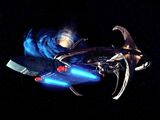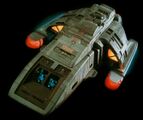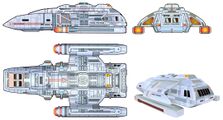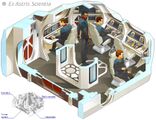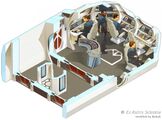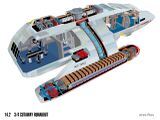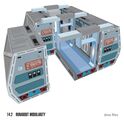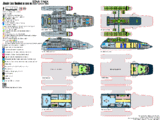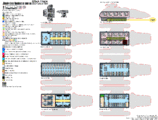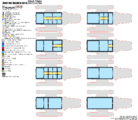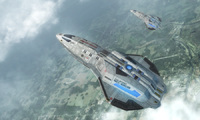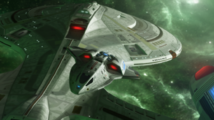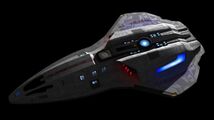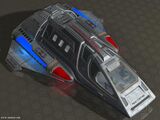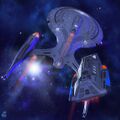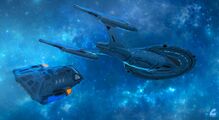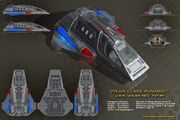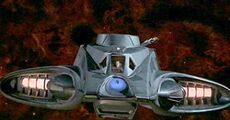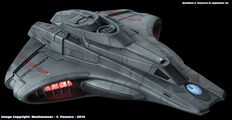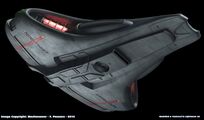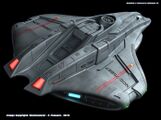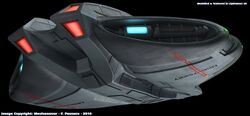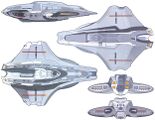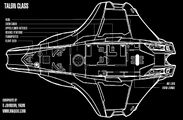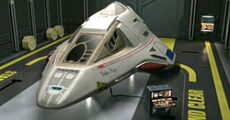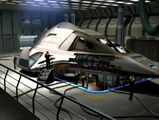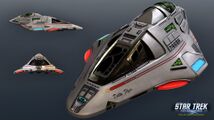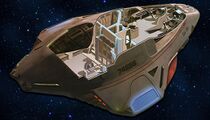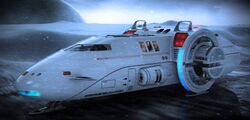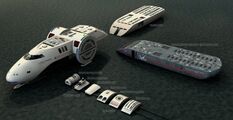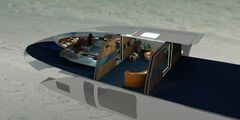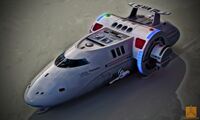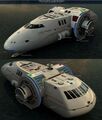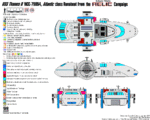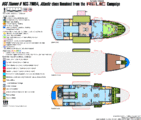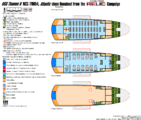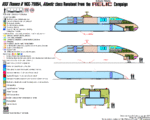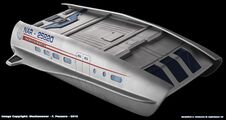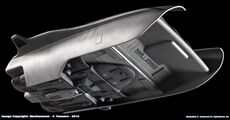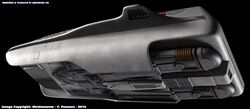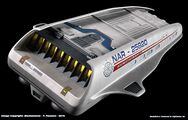Difference between revisions of "Runabouts"
| Line 116: | Line 116: | ||
| torpLaunchers = | | torpLaunchers = | ||
}} | }} | ||
Designed originally as a faster, more heavily-armed version of the ''Danube'' class runabout (a project that would eventually become the ''Arrow'' class runabout), the ''Orion'' class project was tailored in the last few months before the [ | Designed originally as a faster, more heavily-armed version of the ''Danube'' class runabout (a project that would eventually become the ''Arrow'' class runabout), the ''Orion'' class project was tailored in the last few months before the [https://memory-alpha.fandom.com/wiki/Dominion_War Dominion War] broke out as a high-speed scout vessel, that vastly outperformed all other small vessels, with an astonishingly-fast warp drive that could top Warp 8 on a regular basis. This vessel was designed to be able to linger in or near enemy space with a small profile and powerful sensor arrays that would be equally as useful for peacetime applications. During its wartime service, it proved especially popular with Starfleet Intelligence, for its ability to get in and out quickly before it could be detected, even without a cloaking device. However, because of this advanced warp drive system, it's systems are consider rather high maintenance and it spends a lot of its life in the hanger. Post-war, this craft has seen service on frontline outposts and starships, enabling explorers to increase their effective range and dramatically improving the effectiveness of patrol vessels. | ||
This vessel is built for the primary mission of scouting, but it can also be used as a high-speed courier for small, sensitive packages or important individuals. It has a normal crew of three, a pilot, a commanding officer, and a mission specialist, but can accommodate a fourth person if necessary. The ''Orion'' can support missions of up to several weeks, with two crew cabins and a mess area, along with a transporter, replicator, and medical supplies. Most of these vessels have been refit with EMH programs as their duties call for them to frequently be out of contact with Starfleet. Access to the vessel is provided by dorsal and ventral hatches, along with a larger hatch on the stern of the craft that is also equipped with an airlock for EVA situations. Tactical systems are relatively light, as the vessel is designed to flee rather than fight, but it does have a forward phaser bank and two aft banks. | This vessel is built for the primary mission of scouting, but it can also be used as a high-speed courier for small, sensitive packages or important individuals. It has a normal crew of three, a pilot, a commanding officer, and a mission specialist, but can accommodate a fourth person if necessary. The ''Orion'' can support missions of up to several weeks, with two crew cabins and a mess area, along with a transporter, replicator, and medical supplies. Most of these vessels have been refit with EMH programs as their duties call for them to frequently be out of contact with Starfleet. Access to the vessel is provided by dorsal and ventral hatches, along with a larger hatch on the stern of the craft that is also equipped with an airlock for EVA situations. Tactical systems are relatively light, as the vessel is designed to flee rather than fight, but it does have a forward phaser bank and two aft banks. | ||
Revision as of 16:28, 10 November 2020
Runabouts occupy a range of usefulness between a shuttle and a small starship. Generally modular in nature, they are built with the "go anywhere, do anything" school of thought, which makes them useful for low-intensity missions independent of their base or mothership. With greater defenses, range, and accommodations, these craft are suited for missions of over a week and can be outfitted for even longer missions when necessary. They are more commonly found aboard starbases, though most starships can handle at least one in their hangers. These are the most capable auxiliary craft in Starfleet.
Danube-class runabout
Template:Specifications The Danube class runabout was designed in the mid-2360s to serve as a standardized utility vehicle across the Federation, capable of low-intensity tasks across multiple mission parameters, ranging from cargo transport to passenger service to scientific missions to medevac. With a standardized cockpit module and warp sled, multiple modules could be used with this class of vessel to do things that simple shuttles could not and that a full starship would be a waste for. This class was intended mainly for starbases though was also assigned to large starships. It remains one of the most common medium-sized craft in service, over thirty years later, because of its utility and survivability.
This class of runabout has a cockpit module that has a standard exterior with two interior variations: the primary differences being that the later module has a free-standing console in the center of the cockpit, while the transporter has been pushed back to its own compartment, rather than being in the cockpit itself. Both modules continue to be produced, though the variation with the free-standing console is more common now. Aft of this, modules can be installed in many different configurations, the most common being a corridor module with four quarter-sized modules connected to it. A single large module, two half modules, and many other combinations can also be achieved. These modules are quick to build and install and have a wide variety of purposes. There is a standardized aft module with a crew rest area, lounge, and replicator, but this can also be customized or omitted when there is a large module that takes up the entirety of the craft aft of the cockpit. Additional roll-bar modules such as torpedo launchers or sensor arrays can be added above the vessel as well.
Armaments are comprehensive, with all-around coverage of phaser arrays and two microtorpedo launchers, and its tactical utility can be increased further with specialized modules that can make it into a formidable patrol vessel.
Arrow-class runabout
Template:Specifications Developed in the late 2380s, the Arrow class runabout is a much larger craft than the Danube class runabout, at around twice its length. It is intended for longer duration missions and can support larger crews. Unlike its smaller cousin, it is less modular; interior spaces can be reconfigured for mission needs, but it is more complicated than simply swapping different modules, so typically these vessels remain in a single configuration for extended periods of time.
These vessels are sleek and angular, with large wings to increase their performance in atmospheric flight. They have several phaser arrays and torpedo launchers, which make them capable patrol ships. The forward cockpit can seat up to nine and there are additional stations and a four-place transporter aft. A crew rest area is located amidships with views out into space, along with compartments that can be configured as bunk rooms or labs. Further aft are other mission configurable spaces and a relatively large cargo hold. Access to the lower deck is provided from ladders amidships as well as ramps leading down from the cockpit's side exits, and this level contains two hatches compatible with most standard docking ports, as well as additional equipment storage. Primary egress and ingress is provided by a forward ramp that lowers from the floor of the sub level.
Configurations of this vessel include as a patrol craft, as a scout, as a small research vessel, as a passenger transport, and as a general utility vessel. They are too large to be used aboard most starships, but they are common at starbases.
Volga-class runabout
Template:Specifications The Volga represents the Federation's best effort at a compromise between the need to provide smaller Starfleet vessels with long-legged runabout support and the limited hangar space which is usually available on such ships. Smaller than many contemporary shuttle designs, the Volga is rated as a runabout due to the remarkable range enabled by her highly efficient warp core and the extensive instrumentation and advanced tactical systems adapted from the Delta Flyer project. While the development of more powerful and capable runabouts has been a boon to Starfleet since their inception in the early 2370's, the large size and extensive maintenance requirements of these high-performance craft have been a persistent barrier to their deployment on small starships or Starfleet installations which would benefit the most strongly from their enhanced capabilities.
The Volga has a relatively large forward cockpit which is similar to a type-11 shuttle, but the forward stations are split. Aft of the cockpit is a two person transporter as well as a crew rest area, followed by a small cargo bay. It is substantially faster than shuttles and has deployable airfoils for enhanced atmospheric performance. These airfoils also have wingtip phaser arrays. This craft operates with a standard crew of six, but can also be configured to carry up to twenty people on shorter missions. It is less modular than other runabouts, as there is much less space available for specialized equipment, but it makes a very capable general support craft for small starships. Entry is provided primarily by a large aft ramp, but there is also a docking port on the top of the craft. Unlike most Federation small craft, the Volga is equipped with landing struts that deploy to allow for appropriate ground clearance when the vessel is on the surface.
Orion-class runabout
Template:Specifications Designed originally as a faster, more heavily-armed version of the Danube class runabout (a project that would eventually become the Arrow class runabout), the Orion class project was tailored in the last few months before the Dominion War broke out as a high-speed scout vessel, that vastly outperformed all other small vessels, with an astonishingly-fast warp drive that could top Warp 8 on a regular basis. This vessel was designed to be able to linger in or near enemy space with a small profile and powerful sensor arrays that would be equally as useful for peacetime applications. During its wartime service, it proved especially popular with Starfleet Intelligence, for its ability to get in and out quickly before it could be detected, even without a cloaking device. However, because of this advanced warp drive system, it's systems are consider rather high maintenance and it spends a lot of its life in the hanger. Post-war, this craft has seen service on frontline outposts and starships, enabling explorers to increase their effective range and dramatically improving the effectiveness of patrol vessels.
This vessel is built for the primary mission of scouting, but it can also be used as a high-speed courier for small, sensitive packages or important individuals. It has a normal crew of three, a pilot, a commanding officer, and a mission specialist, but can accommodate a fourth person if necessary. The Orion can support missions of up to several weeks, with two crew cabins and a mess area, along with a transporter, replicator, and medical supplies. Most of these vessels have been refit with EMH programs as their duties call for them to frequently be out of contact with Starfleet. Access to the vessel is provided by dorsal and ventral hatches, along with a larger hatch on the stern of the craft that is also equipped with an airlock for EVA situations. Tactical systems are relatively light, as the vessel is designed to flee rather than fight, but it does have a forward phaser bank and two aft banks.
Delta-class runabout
Template:Specifications The Delta class was created from the efforts of the crew of the USS Voyager to establish a new, formidable and multi-purpose small craft that could perform tasks well above and beyond that of the Intrepid class' standard Type 9 shuttlecraft. The Type 9 shuttles suffered from being cramped, short-ranged and limited in capabilities, which hampered Voyager's efforts to get home from their estimated 70+ year journey through the Delta Quadrant.
The first of the class, the Delta Flyer, was originally constructed by Lieutenant Commander Tuvok, Lieutenant Tom Paris, Lieutenant B'Elanna Torres, Ensign Harry Kim and Seven of Nine. The Delta Flyer's original mission and reason for construction was to retrieve a multispatial probe from a gas giant, and therefore was outfitted with tetraburnium hull plating which would help it survive the massive amounts of pressure. However, while constructing the Delta Flyer it was decided that the crew would outfit the ship with all the latest and most potent technologies in order to make it a multipurpose vessel to suit all their needs. Eventually Borg-enhanced regenerative shielding, bio-neural gel pack circuitry, retractable warp nacelles, more "pilot-friendly" controls for better control handling, upgraded warp systems and a phaser array system were all installed during the construction of the vessel.
When Voyager returned to the Alpha Quadrant, the Starfleet Corps of Engineers immediately began to implement the design with a few upgrades to the Starfleet systems that Voyager didn't have during the ship's construction. Although somewhat resource-intensive for a runabout, it paid itself off two-fold in its usefulness and abilities. These vessels are highly advanced but they take up a lot of hanger space. Like the more ubiquitous Volga class, they're less modular than the Danube.
New Atlantic-class runabout
Template:Specifications Designed to be the true successor to the modular and highly-useful Danube class runabout, the New Atlantic class runabout is the closest upgrade in terms of size, capabilities, and modularity to her older sister. This class was developed with lessons learned from some of the other runabout classes developed after the Danube but is generally an evolutionary design rather than a revolutionary design; while it uses some novel components, such as annular warp coils, most of her systems are tried-and-true. It is especially popular for long-range missions, as its modules allow it to be equipped with additional fuel and comfortable living quarters.
The ship is slightly longer and taller than the Danube-class, with a cockpit in the nose of the craft on the upper level, followed by crew rest areas, additional crew stations, and small cabins for four. The lower module is especially large and essentially can change this vessel's entire configuration with a single overhaul stop. Configurations for these modules range from passenger modules, to command-and-control modules, to VIP accomodations, to scouting and scientific modules, to tactical modules. In addition, this class has additional mounting points for two modules on the top of the hull, which range from torpedo launchers to phaser cannons, which can turn this ship into a capable gunship for patrols.
In the center of each warp engine are two extendable cylindrical modules which hold two of the craft's phaser arrays, which can rotate to optimize firing solutions. There are also two fixed arrays on the top of the ship.
Executive type runabout
Template:Specifications The Executive type runabout was classified as a shuttle until the category of runabouts was introduced in the mid-24th century. This class of vessel is used to transport dignitaries and senior officers from ground to orbit in relative comfort. It is also capable of intra-system flights and is relatively common in the core worlds. Unlike purpose-built runabouts, however, they aren't capable of long-distance journeys.
Entry is provided through two side hatches, which also separate the cockpit from the seating area. It has a single large impulse engine on the stern and is equipped with standard navigational shielding, but no weapons.

